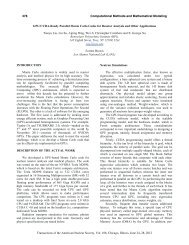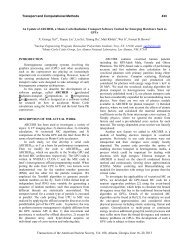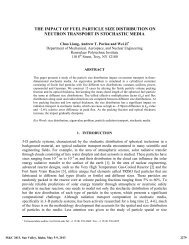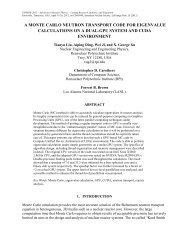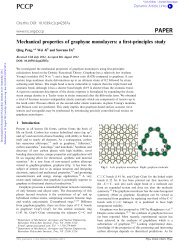Coupled Nuclear-Thermal-Hydraulics Analysis for VHTR - neams
Coupled Nuclear-Thermal-Hydraulics Analysis for VHTR - neams
Coupled Nuclear-Thermal-Hydraulics Analysis for VHTR - neams
- No tags were found...
You also want an ePaper? Increase the reach of your titles
YUMPU automatically turns print PDFs into web optimized ePapers that Google loves.
580 Computational Methods: General<strong>Coupled</strong> <strong>Nuclear</strong>-<strong>Thermal</strong>-<strong>Hydraulics</strong> <strong>Analysis</strong> <strong>for</strong> <strong>VHTR</strong>Gokhan Yesilyurt, Wei Ji, Shikha Prasad, William R. Martin, and John C. LeeDepartment of <strong>Nuclear</strong> Engineering and Radiological SciencesUniversity of MichiganAnn Arbor, Michigan 481091. INTRODUCTIONEf<strong>for</strong>t has been made to determine the beginning-ofcycle(BOC) power distribution <strong>for</strong> the <strong>VHTR</strong> core atrated power of 600 MWt. The MCNP5 code [1] wascoupled with the RELAP5-3D/ATHENA code [2]through a master process utilizing cross plat<strong>for</strong>ms toautomate the process of per<strong>for</strong>ming coupled nuclearthermal-hydraulic(NTH) calculations. We discuss theeffect of thermal-hydraulic (TH) feedback on bothhomogeneous and heterogeneous core configurations.Furthermore, a cross plat<strong>for</strong>m architecture has been set upto couple MCNP5 and RELAP5 code systems, asillustrated in the overall flow chart of Figure 1. Weillustrate in Table 1 how the data are communicatedbetween MCNP5 and RELAP5-3D codes.2. COMPUTATIONAL METHODOLOGYMCNP5 input decks were set up to represent the <strong>VHTR</strong>core with homogeneous and heterogeneous fuelassemblies, which are surrounded by reflectors andgrouped into three annular rings, each ring comprising 10axial fuel segments and clusters of 30, 36, and 36 fuelassemblies, respectively, <strong>for</strong> the inner, middle, and outercore rings. The heterogeneous configuration accountsexplicitly <strong>for</strong> the double heterogeneities associated withthe TRISO particles and fuel compacts, while the fuel andgraphite in each assembly are uni<strong>for</strong>mly mixed in thehomogeneous representation. The pseudo materialconstruct [3] was used to per<strong>for</strong>m interpolations of crosssection libraries generated at a few temperature points bythe DOPPLER code [4]. This enabled us to avoidregenerating hundreds of new nuclear data libraries thatexactly match the temperatures of the <strong>VHTR</strong> core beinganalyzed at each MCNP5-RELAP5 iteration.Axial power fractions were determined <strong>for</strong> 10 axialzones <strong>for</strong> each of the three rings through MCNP5calculations. Axial power fractions were input toRELAP5 to determine assembly-average temperaturedistributions. New RELAP5 temperature distributionswere used <strong>for</strong> next MCNP simulation to obtain newpower fractions. MCNP5 and RELAP5 iterations wereper<strong>for</strong>med in a cyclic fashion until convergence intemperature and power distributions were obtained.Furthermore, 100K particles per cycle were used with atotal of 140 active cycles <strong>for</strong> each MCNP5 calculation.The most CPU intensive part of the coupled NTHcalculational system is MCNP5, which was compiled withMPI libraries using IBM XLF Fortran compiler to run ona powerful G5 cluster utilizing 8 CPUs in parallel.Figure 1. Architecture of coupled NTH system3. RELAP5-3D ANALYSISFor RELAP5-3D/ATHENA calculations, we modeledthe core with three annular regions consisting of 30, 36,and 36 fuel stacks, consistent with the MCNP5 setup.Each annular region is axially discretized into tensegments and is represented [5] as a cylindrical coolantchannel comprising a central coolant hole, surrounded bythree inner graphite rings, four fuel rings, and one outergraphite ring. An adiabatic boundary condition isimposed at the outer boundary of the coolant channel.Based on the NGNP target [6] <strong>for</strong> the helium outlet
Computational Methods: GeneralTable 1. <strong>Coupled</strong> NTH data communication <strong>for</strong> inner ring581<strong>for</strong> the homogeneous and heterogeneous coreconfigurations, respectively.temperature of 1273 K, together with the inlettemperature of 763 K, we determined a helium mass flowrate of 226 kg/s <strong>for</strong> rated power output of 600 MWt. Abypass flow fraction of 12.5 % was assumed, with theremaining flow distributed according to the number offuel assemblies <strong>for</strong> each of the three coolant channels.4. COUPLED NTH RESULTSConverged temperature and power distributions <strong>for</strong> theinner, middle and outer rings are illustrated in Figure 2 <strong>for</strong>the homogeneous model, while a comparison is made inFigure 3. Comparison of Converged power andtemperature distributions <strong>for</strong> the homogeneousand heterogeneous models5. SUMMARY AND CONCLUSIONSA cross-plat<strong>for</strong>m computer architecture connecting aMac G5 cluster and a Windows server was successfullydeveloped to automate the coupled NTH calculations <strong>for</strong>the <strong>VHTR</strong> core. <strong>Coupled</strong> MCNP5-RELAP5-3Dcalculations show that the converged power distributionsare nearly independent of the heterogeneities representedin the neutronic calculations.REFERENCESFigure 2. Converged power and temperaturedistributions <strong>for</strong> the homogeneous modelFigure 3 between the homogeneous and heterogeneousconfigurations. Figure 3 clearly indicates that thetemperature distributions <strong>for</strong> the two representations arenearly identical, with differences of ~10 K. The powerdistributions <strong>for</strong> the homogeneous model were shifted alittle more to the top of the core because of a morenegative temperature coefficient of reactivity. Thedifferences in the power distributions may be summarizedby the axial offset (AO) of power, which is defined as thenormalized difference in power between the top andbottom halves of the core. For the converged <strong>VHTR</strong>power distribution, we obtain AO of 16.2 % and 15.1 %1. Monte Carlo Team, 2003. MCNP – A General MonteCarlo N-Particle Transport Code, Version 5, LA-UR-03-1987. Los Alamos National Laboratory.2. The RELAP5-3D Code Development Team,"ATHENA Code Manual," INEEL-EXT-98-00834,Rev. 2.2, Idaho National Engineering andEnvironmental Laboratory (2003).3. Conlin, J.L., Ji, W., Lee, J.C., and Martin, W.R.,"Pseudo Material Construct <strong>for</strong> <strong>Coupled</strong> Neutronic-<strong>Thermal</strong>-Hydraulic <strong>Analysis</strong> of VHTGR," Trans. Am.Nucl. Soc. 92, 225 (2005).4. MacFarlane, R. E. and P. Talou, 2003, “DOPPLER:A Utility code <strong>for</strong> Preparing CustomizedTemperature-Dependent Data Libraries <strong>for</strong> theMCNP Monte Carlo Transport Code,” InternalMemorandum, Los Alamos National Laboratory.5. C. Davis, Private communication, June 2004.6. P. E. MacDonald, "NGNP Preliminary Point Design– Results of the Initial Neutronics and <strong>Thermal</strong>-Hydraulic Assessments," INEEL/EXT-03-00870Rev. 1, Idaho National Engineering andEnvironmental Laboratory (2003).



